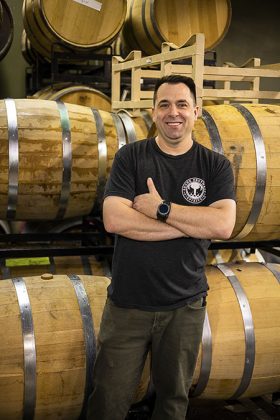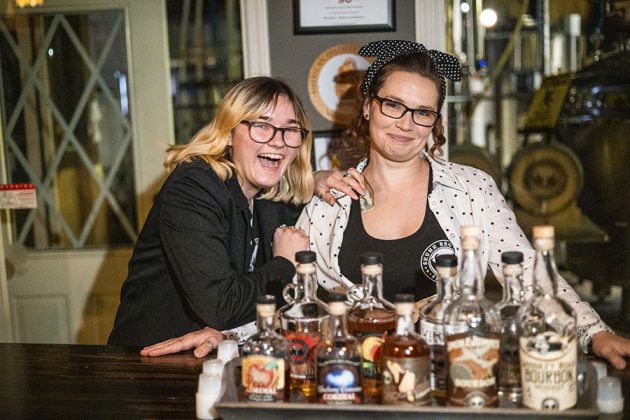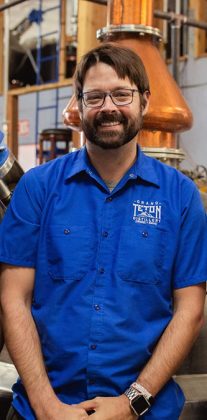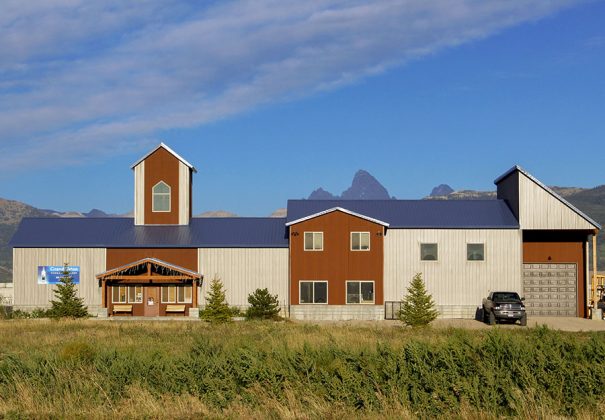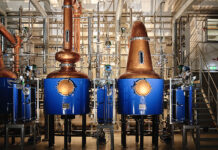When the family behind Skunk Brothers Spirits wanted to take their ancestral moonshine legacy to the next level, they didn’t have to don wings and fly to Wall Street to do it, rather they just kept pouring corn whiskey for friends and neighbors in the foggy Columbia Gorge. It was these bourbon-lovers of the Pacific Northwest who became some of the first believers bankrolling the distillery’s expansion.
Nearly 800 miles to the east, the personalities behind Grand Teton Distillery were looking to build-out their high-desert tasting room, making a destination for the hundreds of thousands of tourists who pass by on their way to Yellowstone National Park. Yet the team didn’t turn to the whales of “Shark Tank” or elusive angel investors for backup. Instead, they turned to locals who enjoy Grand Teton’s whiskey so much that they were already participating in its “adopt a barrel” program.
Skunk Brothers Spirits and Grand Teton Distillery each brought their business dreams to fruition by venturing into equity crowdfunding.
Similar to mainstream crowdfunding — ubiquitous for a decade now thanks to platforms like Kickstarter and Indiegogo — this off-shoot of the phenomenon allows people with faith or curiosity in a product to use their own cash to help it; but in this case, instead of getting products, swag, public recognition and a warm, tingling feeling as return, the supporters get a genuine financial stake in the company through equity shares. For craft distillers, this means fans of their operation can become part-owners, at the same time sparking the momentum to attract broader outside investment during a public crowdfunding campaign.
More than a few creative-minded distillers with limited corporate experience have discovered it’s a way to side-step the financial sector’s landmines while taking a faster, easier path to netting capital. And it’s easy to start a crowdfunding campaign, too. All an alcoholic entrepreneur needs is a following, a small amount of upfront cash and a few months of their time to watch the seeds grow.
“Distilleries have been one of our best-performing spaces,” said John Bullitt, CEO of StartEngine, the equity crowdfunding platform that helped both Skunk Brothers and Grand Teton. “When you open up your company to the general public to invest in it, you’re really opening yourself up to a whole new group of brand ambassadors. These people who do invest, quite literally, have skin in the game to see the company be successful; so, they’re going to be doing everything they can to push it forward. That means buying bottles for friends and family, bringing bottles to parties to introduce it to new people – really driving the revenues that allow a company to grow.”
Getting help without getting skunked
Scott Donohoe’s granddad was the family’s crafty moonshiner, but it is his father’s personality and approach that gave the clan distillery its name. In fact, throughout his life, Donohoe’s rarely heard anyone refer to his pop as anything other than Skunk. The nickname came from one of his dad’s childhood mishaps, absently reaching out of his front door during a snow storm to pull the family’s dog in, only to realize the mound of black and white fur he’d grabbed wasn’t his canine.
“It let him have it,” Donohoe said of the skunk. “He instantly earned his nickname, and he’s had it ever since.”
When Donohoe and his brother opened their family’s distillery seven years ago, they recruited Skunk to be a big presence in its tasting room.
“He’s always the guy who’s the life of the party,” Donohoe observed. “The tasting room, when he’s in there, is roaring with laughter. That’s just his personality. He’s a real trickster — a real joker. So, the name still fits, because he’s kind of a stinker, I guess.”
And what Skunk’s pouring for those coming through the doors includes blueberry, peach and cherry cordials birthed by Washington and Oregon’s famous “fruit loop,” as well as a popular Pacific Ocean-peated bourbon and a rapidly-aged bourbon made with help from Two Trees Distilling. The products have been a regional hit, but Donahoe and company wanted to upgrade the distillery’s equipment and launch an expansion that included wider distribution. Their late friend Mark Robbins, a reliable numbers guy, first suggested equity crowdfunding in late 2018.
Most StartEngine campaigns are active for between four-and-six months, with the majority of investors jumping in during either the initial period, or the final weeks. Skunk Brothers Spirits managed to raise well over a million dollars from just under 2,500 investors. While people familiar with the distillery’s drinks were some of the first to get involved, Robbins’ prediction of expanding the customer base at the same time as the investor base also proved true.
“The campaign actually got our name out there quite a bit, and boosted interest in the company,” Donahoe said.
A grand second option
Grand Teton Distillery spent the last decade creating an award-winning vodka before broadening its appeal with a whiskey made from High West barley. But for most of that time its tasting room in Driggs, Idaho, was small — just a five-guest capacity. That meant the company was leaving a lot of tourist money on the table, since it’s anchored near west gate of Yellowstone National Park. The distillery’s team started eyeing an 8,000 square-foot expansion. They were able to fund much of that through a Small Business Association loan, but some of the project’s aspects couldn’t be covered by those funds, particularly next-level marketing.
“The thing is, how do you really expand without the marketing and working capital aspect of it,” reflected Andrew Boczar, Grand Teton’s head distiller. “We’d already had a limited program for some customers that allowed them to adopt an aging barrel of whiskey, where they get a 10% investment over the time the whiskey’s aging, as well as a bonus and a case of the whiskey. We knew openings in that program are always filled right away, so, when it came to StartEngine, we thought there were already people who wanted more equity in the company besides the barrels.”
Boczar and his co-workers got their crowdfunding campaign moving by first sharing it with the 40,000 customers they already on the distillery’s email list. Those were the Grand Teton patrons that got the initial ball rolling. When the four-month campaign was over, the distillery had raised $344,000 from 356 investors.
Boczar’s biggest piece of advice is understanding these campaigns takes constant updates, outreach and engagement on social media throughout the process.
“If you don’t already have someone with the business who really specializes in running the social media, then you’ll want to get someone who does,” Boczar noted.
Donohoe agrees.
“I had never done a Facebook-type ad campaign before,” he recalled. “At the time, we started out spending like $200 or $300 a day, and we were up to $2,000 or $3,000 a day in some cases. So, you can blow through a lot of money just doing that. You really have to pick your advertisement carefully.”
Facebook continues to make changes to how its targeted advertisement operates, making the challenges even greater.
Lenny Gotter, a consultant and broker for craft distilleries, has run a number of crowdfunding campaigns on multiple platforms. He recommends beginning to pre-plan photos, news flashes and live web events six months prior to the campaign actually starting.
“We make sure that we have content for updates, so once the raise gets started, and we have people involved, they see continual activity from us,” Gotter said. “When you have an email list, you can’t just send out emails every two weeks saying, ‘Hey you should invest! Hey you should invest! Hey you should invest!’ You want to have other things to talk about.”
Other key things for distillers to know is that it’s important to have one’s financial books in order, as there is a mandatory review to participate in equity crowdfunding. It’s also important to budget for attorney consultations, since there are necessary permits or licenses in a given state.
Boczar stresses that the effort, if you really put it in, is worth it.
“It’s a good thing, but if people are wanting to do it, they need to have the mindset that it’s going to be a lot of work on their part,” he said. “You can’t just turn on a campaign, sit back and do nothing, and expect big things to happen.”

